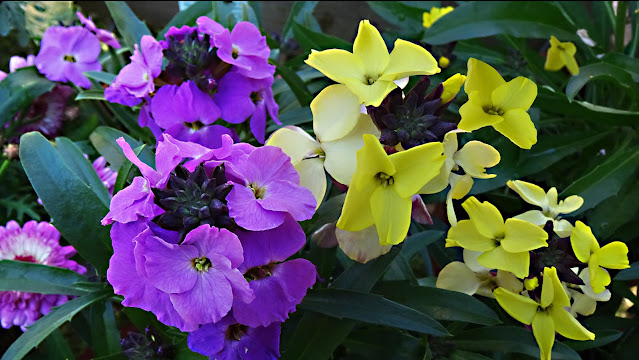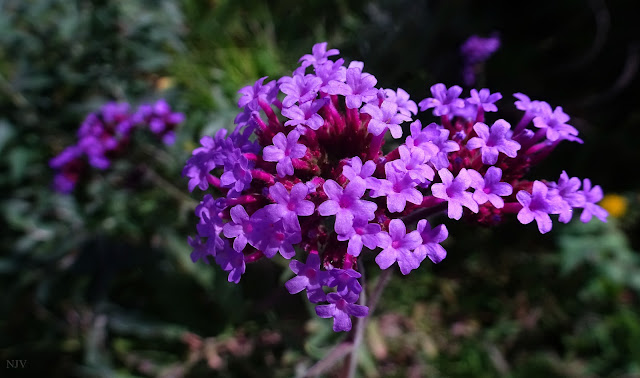This is a blog where I post my favourite photographs from around the places I've visited. I am an amateur photographer and I am ever learning as I go along!
Thursday, 29 December 2022
KURRAJONG
Thursday, 22 December 2022
ROSEMARY
Thursday, 15 December 2022
DAHLIA
Thursday, 8 December 2022
Thursday, 1 December 2022
RHODODENDRON 'KATE'
Thursday, 24 November 2022
CAMPANULA
Thursday, 17 November 2022
RHODODENDRON
Thursday, 10 November 2022
Thursday, 3 November 2022
TEA TREE
Thursday, 27 October 2022
LILIUM
Lilium ‘Tiny Double You’ is a dwarf Asiatic lily (Plant number: 1.318.840) and one of the Lily Looks™ series developed in the Netherlands. Bred originally for containers, these are versatile garden plants as well. The dwarf habit makes them useful near the front of any sunny border where they put on a great midsummer show. Also equally at home in a rock garden. The best effect comes from massing in good-sized clumps of one variety.
This selection is unique and new to the series with large, upfacing double, orange flowers. It is an outstanding garden plant and its unlicensed propagation is prohibited! It is suited to a full sun or partial shade position and will grow in most soil types. It grows to 30-35 cm and blooms in mid-summer. It is deer-resistant and does well in rockeries, borders, massed displays and in containers.
This post is part of the Floral Friday Fotos meme.
Thursday, 20 October 2022
Thursday, 13 October 2022
CROWEA
Thursday, 6 October 2022
Thursday, 29 September 2022
Saturday, 24 September 2022
EASTERN ROSELLA
Friday, 23 September 2022
Thursday, 22 September 2022
SPEEDWELL
Tuesday, 20 September 2022
LONDON, UK
London is the capital and most populous city of England and the United Kingdom. Standing on the River Thames in the south east of the island of Great Britain, London has been a major settlement for two millennia. It was founded by the Romans, who named it Londinium. London's ancient core, the City of London, largely retains its 1.12-square-mile (2.9 km2) medieval boundaries. Since at least the 19th century, "London" has also referred to the metropolis around this core, historically split between Middlesex, Essex, Surrey, Kent, and Hertfordshire, which today largely makes up Greater London, governed by the Mayor of London and the London Assembly.
London contains four World Heritage Sites: the Tower of London; Kew Gardens; the site comprising the Palace of Westminster (image below), Westminster Abbey, and St Margaret's Church; and the historic settlement of Greenwich (in which the Royal Observatory, Greenwich marks the Prime Meridian, 0° longitude, and GMT). Other famous landmarks include Buckingham Palace, the London Eye, Piccadilly Circus, St Paul's Cathedral, Tower Bridge, Trafalgar Square, and The Shard. London is home to numerous museums, galleries, libraries, sporting events, and other cultural institutions, including the British Museum, National Gallery, Natural History Museum, Tate Modern, British Library, and West End theatres. The London Underground is the oldest underground railway network in the world.
This post is part of the Travel Tuesday meme.
Thursday, 8 September 2022
ISOPOGON
Thursday, 25 August 2022
CAPE DAISY
Osteospermum is a genus of flowering plants belonging to the Calenduleae, one of the smaller tribes of the sunflower/daisy family Asteraceae. The common name is African daisy or Cape daisy. Osteospermum used to belong to the genus Dimorphotheca, but only the annual species remain in that genus now; the perennials have been placed in the genus Osteospermum. Osteospermum is also closely related to the small genus Chrysanthemoides, and the resemblance is seen in species such as C. incana and C. monilifera.
This post is part of the Floral Friday Fotos meme.
Sunday, 14 August 2022
Thursday, 11 August 2022
Thursday, 28 July 2022
HELLEBORE
Thursday, 21 July 2022
ORCHID
Thursday, 14 July 2022
Thursday, 23 June 2022
JONQUIL
Narcissus jonquilla (jonquil, rush daffodil) is a bulbous flowering plant, a species of Narcissus (daffodil) that is native to Spain and Portugal, but has now become naturalised in many other regions: France, Italy, Greece, Turkey, the former Yugoslavia, Madeira, British Columbia, Utah, Illinois, Ohio, and the southeastern United States from Texas to Maryland.
Narcissus jonquilla bears long, narrow, rush-like leaves (hence the name "jonquil", Spanish junquillo, from the Latin juncus = "rush"). In spring it bears heads of up to five scented yellow or white flowers. It is a parent of numerous varieties within Division 7 of the horticultural classification. Division 7 in the Royal Horticultural Society classification of Narcissus includes N. jonquilla and N. apodanthus hybrids and cultivars that show clear characteristics of those two species.
N. jonquilla has been cultivated since the 18th century in France as the strongest of the Narcissus species used in Narcissus Oil, a component of many modern perfumes.
This post is part of the Floral Friday Fotos meme
Thursday, 16 June 2022
JAPONICA
Thursday, 9 June 2022
AZURE SAGE
Salvia azurea, the azure blue sage, azure sage, blue sage or prairie sage, is a herbaceous perennial in the genus Salvia, family Lamiaceae, that is native to Central and Eastern North America. Its thin, upright stems can grow to 1.8 m tall, with narrow, pointed, smooth-edged to serrated, furry to smooth green leaves, connected to their stems by petioles to 1.0 cm long. There are no basal leaves.
The blue (rarely white), flowers nearly 6.4 to 12.7 mm long, appear summer to autumn near the ends of their branched or unbranched spikes; their calyxes are tubular or bell-shaped and furry. Two varieties are Salvia azurea var. azurea (azure sage) and Salvia azurea var. grandiflora (pitcher sage). It is found on the wild on roadsides, glades, fields and pastures.
This post is part of the Floral Friday Fotos meme.
Thursday, 2 June 2022
PETREA
Petrea is a genus of evergreen flowering vines native to Mexico and Central America. They have rough-textured leaves, hence the common name "sandpaper vine". It looks somewhat similar to a tropical Wisteria.
Shown here is Petrea volubilis. Carolus Linnaeus named Petrea in honour of Robert James Petre, 8th Baron Petre of Ingatestone Hall in Essex. Petre was a patron of botany.
This post is part of the Floral Friday Fotos meme.
Thursday, 19 May 2022
Thursday, 12 May 2022
PATTERSON'S CURSE
Thursday, 28 April 2022
CLEMATIS
Clematis is a genus of about 300 species within the buttercup family Ranunculaceae. Their garden hybrids have been popular among gardeners, beginning with Clematis × jackmanii, a garden standby since 1862; more hybrid cultivars are being produced constantly.
They are mainly of Chinese and Japanese origin. Most species are known as clematis in English, while some are also known as traveller's joy, a name invented for the sole British native, C. vitalba, by the herbalist John Gerard; virgin's bower for C. viticella; old man's beard, applied to several with prominent seedheads; and leather flower or vase vine for the North American Clematis viorna.
Illustrated here is the splendid hybrid Clematis 'Daniel Deronda'. Introduced in 1882, 'Daniel Deronda' still holds its own among modern varieties and has given the Royal Horticultural Society's prestigious Award of Garden Merit (AGM) in recognition of its outstanding excellence. It produces purple-blue flowers throughout the summer. These are semi-double early in the season and then single later on. The blooms are followed by eye-catching seed-heads which have a twist at the top.
To prune, remove any dead or weak stems in late winter or early spring and cut remaining stems back to the highest pair of strong-growing buds. To encourage blooms to cover the whole plant, train the stems so that they are evenly spaced on their support. As new growth appears in mid-spring, train this to fill any gaps. Plant in a sheltered position that is not north-facing.
This post is part of the Floral Friday Fotos meme
Thursday, 7 April 2022
CHINESE LANTERN
Abutilon or 'Chinese lanterns' are closely related to hibiscus, and most of the hundred or so species have pendulous, hibiscus-like flowers. Cultivars produced by hybridising some of the South American abutilons have all been placed in one group known as Abutilon x hybridum, and these are the ones most commonly grown in Australian gardens.
They have a wispy, delicate form and colourful, lantern-shaped flowers. For gardeners who prefer plants with a more dense habit, new compact varieties are also available. Another popular abutilon is Abutilon megapotamicum, which is a prostrate or ground covering species with small orange flowers. Abutilon are evergreen shrubs with attractive maple-like leaves and an open, pendulous habit. They grow to about 2-3 metres tall.
Flowers in the Southern Hemisphere are produced in September to December, but they spot flower at other times. Flower colours include white, pink, red, yellow, orange and salmon. These plants grow well in most parts of Australia, except for the very cold mountain zones. In inland areas be sure to water well and keep protected with mulch. In hot inland climates abutilons appreciate some light shade.
This post is part of the Floral Friday Fotos meme.
Thursday, 31 March 2022
CHOCOLATE COSMOS
Cosmos atrosanguineus, the chocolate cosmos, is a species of Cosmos, native to Mexico, where it is extinct in the wild. The species was introduced into cultivation in 1902, where it survives as a single clone reproduced by vegetative propagation.
Cosmos atrosanguineus is a herbaceous perennial plant growing to 40–60 cm tall, with a fleshy tuberous root. The leaves are 7–15 cm long, pinnate, with leaflets 2–5 cm long. The flowers are produced in a capitulum 3-4.5 cm diameter, dark red to maroon-dark brown, with a ring of six to ten (usually eight) broad ray florets and a centre of disc florets typical of the Asteraceae family.
The flowers have a light vanillin fragrance (like many chocolates), which becomes more noticeable as the summer day wears on. The single surviving clone is a popular ornamental plant, grown for its rich dark red-brown flowers. It is not self-fertile, so no viable seeds are produced, and the plant has to be propagated by division of the tubers, or by tissue culture.
It requires partial sun or full sun, and flowers from mid- to late summer. It is frost-sensitive (Zones 6-11); in temperate zones, the tuber has to be dug up and stored in a frost-free store over the winter.
This post is part of the Floral Friday Fotos meme
Friday, 25 March 2022
Thursday, 17 March 2022
EVERGREEN AZALEA
Thursday, 10 March 2022
SUNRING
Thursday, 24 February 2022
WALLFLOWERS
Thursday, 10 February 2022
SUNFLOWERS
Sunday, 30 January 2022
Thursday, 27 January 2022
XERANTHEMUM
Xeranthemum annuum (immortelle; everlasting) is an annual herb with an erect and branched stem, 20–50 cm high. The leaves are alternate, sessile, linear, densely white downy, the flower-heads are solitary, petal-like involucral bracts are spreading, pink, lilac, rarely white, tubular florets are purple. The fruit is an achene.
It is a native of Central, Southeastern and Eastern Europe, Caucasus and Western Asia (Iran, Lebanon, Syria). It grows on sunny slopes, in vineyards, on river and lake banks, from lowlands to foothills. Flowers from May to August. A very popular garden plant, may be used as a cut or dried flower.
This post is part of the Floral Friday Fotos meme

















































